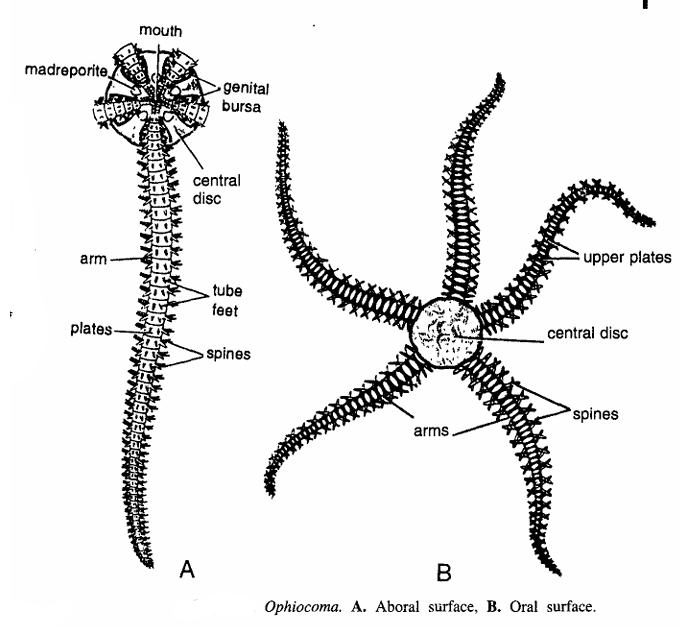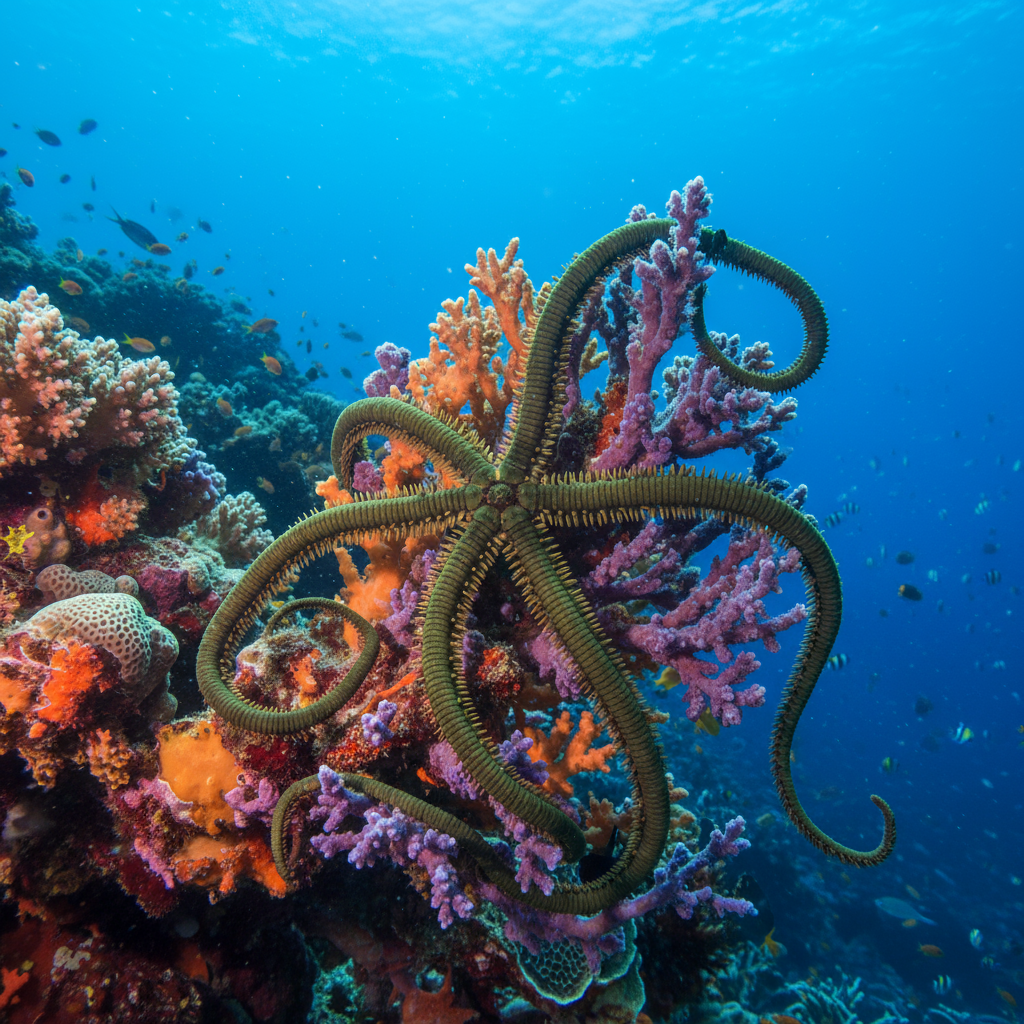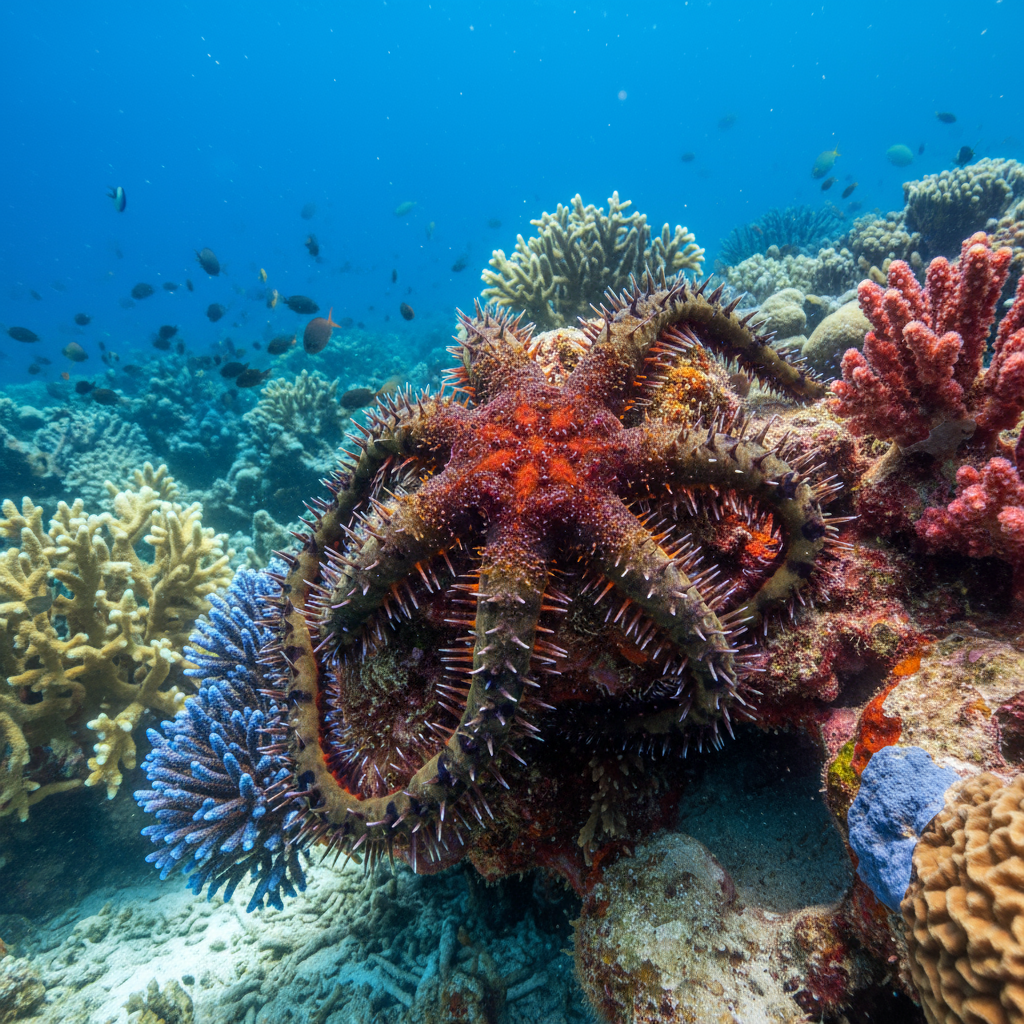Ophiocoma: Comprehensive Overview of Morphology, Classification, Habitat, Behavior, and Ecological Role
Ophiocoma is a genus of brittle stars under the family Ophiocomidae within the class Ophiuroidea, phylum Echinodermata. These marine organisms are closely related to sea stars but differentiated by their slender, highly flexible arms which they use for movement and feeding. Ophiocoma species are widely distributed in tropical and subtropical oceans, primarily inhabiting coral reefs, rocky substrates, and seagrass beds. Their unique physiology, behavior, and ecological importance make them subjects of considerable biological and marine scientific research.
Classification of Ophiocoma
| Taxonomic Rank | Name | Characteristic |
|---|---|---|
| Kingdom | Animalia | Multicellular, heterotrophic eukaryotic organisms |
| Phylum | Echinodermata | Marine invertebrates with radial symmetry and calcareous endoskeletons |
| Class | Ophiuroidea | Brittle stars with articulated, flexible arms |
| Order | Ophiurida | Distinct central disc with long, slender arms |
| Family | Ophiocomidae | Brittle stars with spiny arm segments and colorful discs |
| Genus | Ophiocoma | Brittle stars recognized for their arm spines and extraocular visual abilities |

Habitat and Habit
Ophiocoma species inhabit shallow marine environments such as coral reefs, rocky outcrops, and seagrass meadows across tropical and subtropical seas. They tend to hide under rocks, coral rubble, or crevices during daylight to avoid predation, becoming active mostly at night. These brittle stars use their flexible arms to crawl rapidly across the sea floor or cling onto substrate surfaces.
They engage in carnivorous and scavenging behaviors, feeding on detritus, small invertebrates, and plankton. Their feeding involves surface-film techniques where arms sweep over the water surface to trap suspended particles with mucous-covered spines. Regenerative capabilities allow them to survive arm loss due to predation or environmental challenges.
Geographical Distribution
The genus Ophiocoma has a broad geographical range in tropical and subtropical oceans globally. They are common in the Indo-Pacific region, including the Red Sea, Australia, Southeast Asia, and the Pacific Islands. They also occur in parts of the Caribbean and the Western Atlantic Ocean. Their adaptability to various habitats within these regions makes them a prominent benthic fauna component.

General Characteristics
Ophiocoma brittle stars have a striking morphology characterized by:
- Commonly called as brittle star.
- Body consists of a small, rounded central disc and 5 long slender, tapering arms, which are inserted on the under-surfaces of the disc.
- Central disk and arms quite distinct.
- Arms are distinctly marked off from the central disc and do not have prolongations of perivisceral coelom and alimentation.
- Oral and aboral surfaces are distinctly marked. Oral surface has leathery skin.
- Anus and pedicellariae absent. Oral surface has a central, pentagonal mouth opening and indistinct inter-radial oral madreporite.
- The ambulacral grooves covered.
- There are 10 elongated slits, two on either side of the base of each arm, called as genital bursae in which gonoducts open.
- Three rows of pointed spines are borne on lateral plates.
- Single row of short tube feet projects on each side between lower and lateral plates. Ossicles of arms are articulating.
- A pentagonal central disc covered with granules or plates, varying in color from browns, reds, greens to blues.
- Five long, slender arms that taper outward, covered with rows of small spines and armored plates for protection.
- An oral surface with a small central mouth surrounded by denticulate jaws.
- Tube feet limited in locomotion, serving primarily to move food particles to the mouth and for sensory functions.
- A water vascular system that hydraulically powers arm movement through fluid pressure changes.
Adults typically measure a few centimeters in diameter, with arm spans significantly longer. Coloration varies considerably, often contributing to camouflage within reef environments.
Special Features
One of Ophiocoma’s remarkable traits is its capacity for extraocular vision through spatially distributed photoreceptors along its arms. Despite lacking conventional eyes, Ophiocoma can detect light direction and movement, enabling them to recognize predators and choose optimal shelter locations.
Their regenerative ability is highly developed, allowing the replacement of lost arms. This natural defense mechanism is coupled with arm autotomy, allowing self-detachment when under threat.
Ophiocoma’s feeding strategy, including surface-film feeding, is unique among brittle stars, enabling exploitation of food resources unavailable to others.

Behavior and Ecology
Ophiocoma brittle stars are primarily nocturnal, reducing predation risk. Their rapid arm-driven movement distinguishes them from their more sedentary relatives. They play important trophic roles in reef ecosystems as scavengers and micro-predators, recycling organic matter and controlling small invertebrate populations.
Their presence enhances substrate health and structure through bioturbation caused by movement and burrowing actions. They serve as prey for fish and other reef predators, integrating into the wider marine food web.
Reproduction and Life Cycle
Reproduction in Ophiocoma is sexual with separate sexes. During breeding seasons, males and females release sperm and eggs into the water column, where external fertilization occurs. The planktonic larvae, called ophiopluteus, develop over several stages before settling on the benthos and metamorphosing into juvenile brittle stars.
Some species within the genus have shown evidence of asexual reproduction through larval cloning, further supporting population resilience. Regeneration supplements reproductive success by maintaining individual health and functionality post-predation injury.
Conservation and Research Importance
While Ophiocoma species are not currently endangered, changes in coral reef environments and ocean health pose potential threats. Habitat destruction and reef bleaching could impact their populations, emphasizing ecosystem conservation.
Research into Ophiocoma’s visual system, regenerative mechanisms, and feeding adaptations contributes substantially to understanding echinoderm biology, sensory ecology, and evolutionary developmental biology. Their capabilities offer models for biomedical and bioengineering studies related to regeneration and distributed sensory processing.
References
- https://sunankalijaga.org/prosiding/index.php/icse/article/download/635/606/1196
- https://www.sealifebase.se/summary/Ophiocoma-scolopendrina
- https://en.wikipedia.org/wiki/Ophiocoma_scolopendrina
- https://animaldiversity.org/accounts/Ophiocoma_echinata/
- https://www.scientificamerican.com/article/the-brittle-star-that-sees-with-its-body/
- https://en.wikipedia.org/wiki/Brittle_star
- https://repository.si.edu/bitstreams/ab812d76-3c52-47ea-9339-f0d515920408/download

